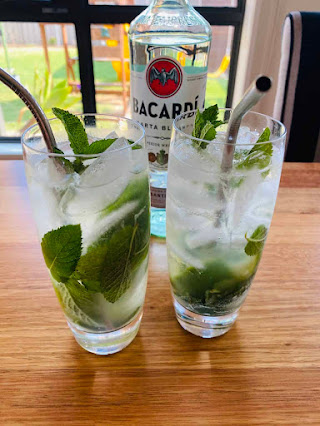Mojito (pronounced moh-hee-toh)
A
cocktail of Cuban origin, made with white rum, sugar-cane juice, lime juice,
soda-water and mint.
1930–1935: From American-infused Cuban Spanish, perhaps a diminutive of the Spanish mojo (orange sauce or marinade) from mojar (to moisten; make wet) from the (hypothetical) Vulgar Latin molliāre (to soften by soaking), from the Latin molliō (soften), from mollis (soft). The noun plural is mojitos. The origin of the name mojito is disputed. The most popular is that the name relates mojo, a Cuban seasoning made from lime and used to flavour dishes. The alternative view is it’s a derivative of mojadito ("a little wet" in Spanish), the diminutive of mojado (wet). Mojito is a noun, the noun plural is Mojitos and by convention, it seems mostly to appear with an initial capital.
Ingredients
Juice
of 1 large lime.
1
teaspoon granulated sugar.
Small
handful of mint leaves, plus extra sprig to serve.
60ml white
rum.
Soda-water
to taste.
Method
(1) Muddle
lime juice, sugar & mint leaves in small jug, progressively crushing
mint. Pour into tall glass, adding
handful of ice.
(2) Using
chilled glass, pour over rum, stirring with long-handled spoon. Top-up with soda water, garnish with mint and
serve.
To create a virgin mojito, omit rum.
Lindsay Lohan enjoying ice-cream and (an allegedly virgin) mojito, Monaco 2015.
It’s not uncommon for the origin of the names of cocktails to be both obscure and contested. Before the modern era, something like a cocktail could be uniquely regional, something well known in one part of a city yet unknown in another and around the world, because what seemed an appealing combination of drinks in one place would likely be tried in others, it’s a certainty many cocktails would independently have been “invented” many times. So it’s impossible to know when, where or by whom a great number were first concocted and the contested history tends to be as much about the names as the recipes. The Mojito, which has gained a new popularity in the twenty-first century, has a typically murky past and there are a number of stories which claim to document its origin, the best-known of which centres on Havana’s La Bodeguita del medio, a restaurant in which Nobel literature laureate Ernest Hemingway (1899–1961) spent many hours, sitting in the bar; Hemmingway lent lavish praise to Bodeguita del medio’s version of the Mojito and he was a fair judge of such things. The restaurant claims to be the first place on the planet to have served the drink, the recipe coming from African slaves working the Cuban sugar cane fields who created the mix from aguardiente de cana (literally “firewater of the sugar cane”). In this telling it thus started life as a simply distilled spirit from the cane cuttings and the name Mojito fits this tale, the Spanish mojo meaning “to place a little spell”. That lacks the documentary evidence etymologists prefer but points are gained for romance.
Sir Francis Drake (circa 1540–1596) was a English sailor remembered for his role in defeating the Spanish Armada in 1588 but he was also a pirate (the English preferred the term “privateer”, pirates being “foreigners”), an aspect of his character which appealed to many including Hermann Göring (1893–1946; leading Nazi 1922-1945, Hitler's designated successor & Reichsmarschall 1940-1945) who reckoned the decline of England was due to pillaging buccaneers like Drake being replaced by “shopkeepers” (as he would characterize Westminster politicians). One of Drake's ventures was a plan to take Havana harbor from the Spanish and sack the city of its gold, the holdings there known to be vast but a survey of the place’s formidable defences led him to abandon that idea. By then however many of his crews were suffering scurvy and dysentery which threatened the continuation of his voyage anywhere so, because Cuba’s native populations were known to have effective remedies for many diseases, Drake sent ashore a landing party to trade this and that for the ingredients for a medicine. The sailors returned with aguarediente de cana (mint leaves mixed with lime juice & the spirit distilled from sugar cane) and the tonic proved efficacious. As the Admiralty would later understand, it was the lime juice which was most effective (and it would later be supplied on ships to end the problem of scurvy by providing the needed daily dose of vitamin C) but it would have been the spirit which made the potion more palatable to seamen. A cocktail made with a similar mix was widely served in Cuba in the years after the abortive raid and this may have been the first commercially available Mojito although it didn’t use the name: it was called the El Draque. It’s thus possible African slaves may not have mixed the first version but they may be responsible for the Mojito moniker, the Spanish mojadito (a little wet) and the Cuban lime-based seasoning mojo the other candidates. Whatever the source, all agree it was the foundation of the Bacardi company in the mid nineteenth century which started the spread and Hemmingway’s imprimatur from the comfort of Bodeguita del medio’s bar stools was enough for it to begin its rise to the point where the Mojito is among the most popular modern cocktails.



No comments:
Post a Comment